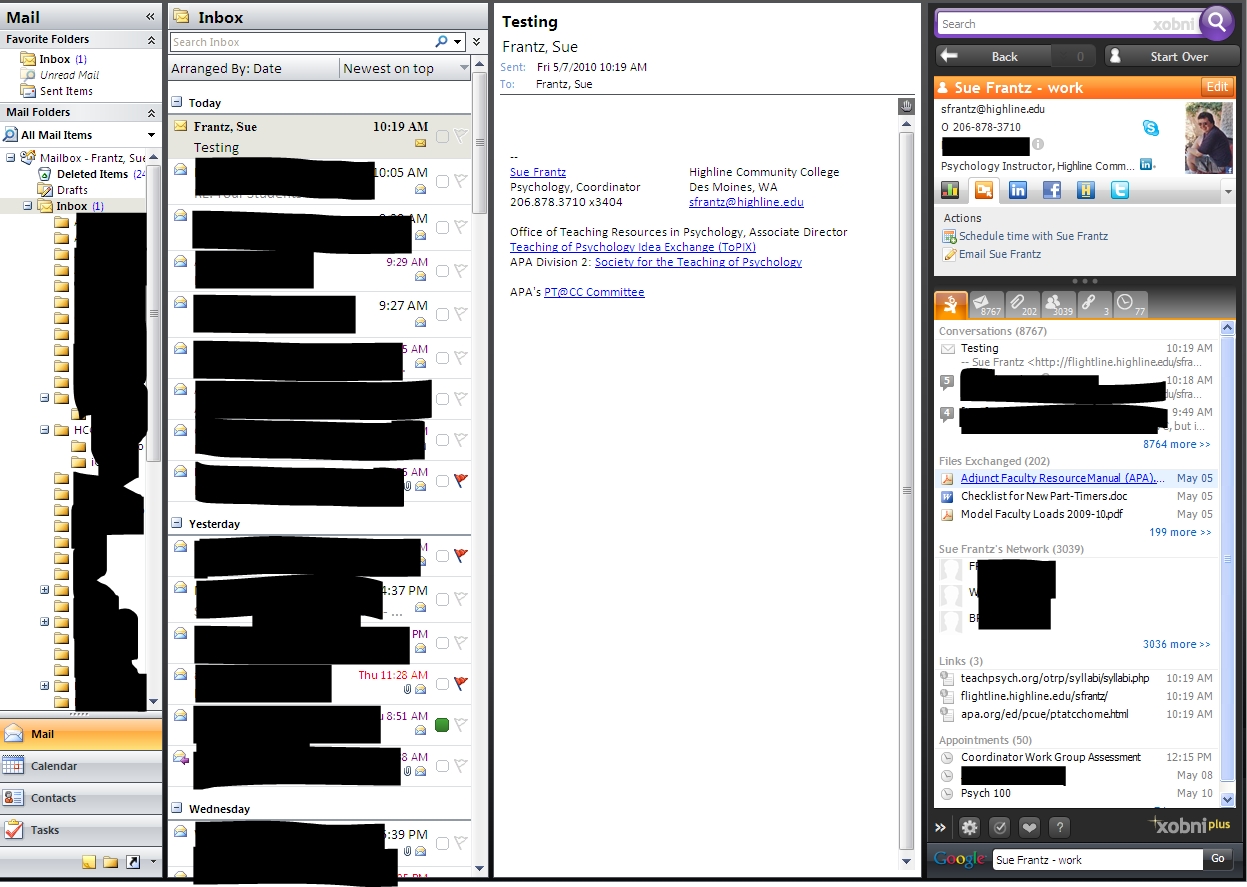Xobni [inboX]: Not Just Another Outlook Addin
Xobni allows me to quickly find email messages, attached files, and contact information for anyone who has ever emailed me. With the large number of students each term as well as various committee responsibilities and other collaborative projects, Xobni has made managing the onslaught of email much easier! For example, when I agree to write a letter of recommendation for a student, I turn to Xobni to call up all previous emails and files exchanged with that student. Within those I often find specific examples I can use in writing the letter.
Most of Xobni‘s functionality can be found in its free version. For a one-time $29.95 fee, you can upgrade to Xobni Plus which gives you a bit more power. Everything in this post, I believe, is included in the free version. Click here to see a comparison between Xobni and Xobni Plus. (If you tried Xobni before, you may have found that it slowed Outlook down when starting. With improvements, Xobni doesn’t slow it down as much. It’s worth trying again.)
This is what my Outlook inbox looks like. Xobni occupies the fourth column. Whatever message is selected, Xobni displays the information for that sender. In this case, I’ve emailed myself and have that message selected, so my information is displayed. This is my Xobni profile as it appears in my Outlook.
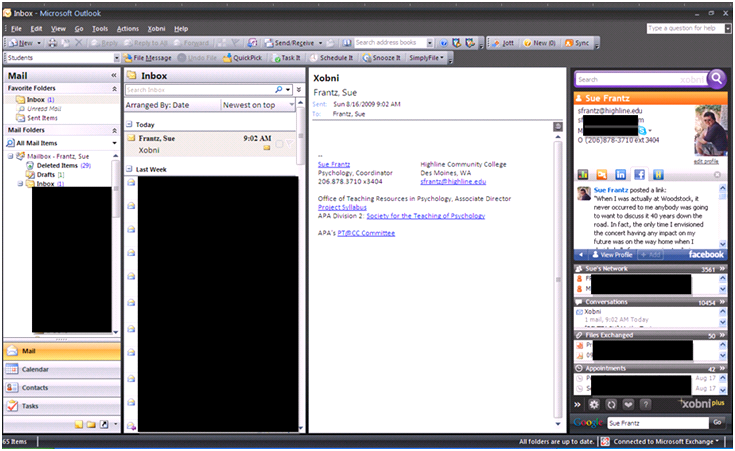
Xobni gives me all sorts of information about the sender, e.g., contact information such as email addresses and phone numbers. I have the Facebook icon selected so I get the sender’s most recent status update (assuming the sender and I are Facebook ‘friends’ or the sender’s Facebook profile is public).
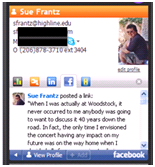
Selecting the other icons in the center of the image above produces a wealth of information.
Analytics. This graphic shows how many emails I’ve sent and received and when I’ve received them. If I had someone else selected in Xobni, I would see how many emails I have sent them, how many they have sent me, and when they have sent them.
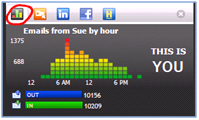
Actions. Clicking the orange ‘actions’ icon allows me to email the person. (Remember, Xobni displays the information for any person whose email you have selected in your inbox.) If I click “Email Sue,” a new message pops up with the email address already filled in. If I click “Schedule a time with Sue,” Xobni not only opens a new email message, but it also accesses my Outlook calendar, automatically enters my free times for the next 5 working days, enters my standard sign off and signature information. Very handy!
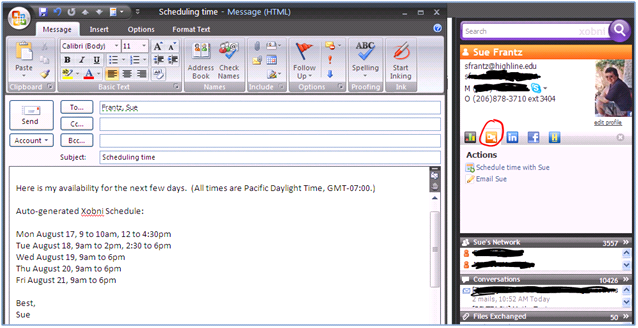
LinkedIn. Click the LinkedIn icon to call up information from the person’s LinkedIn profile.
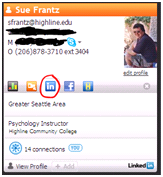
Hoovers. Hoovers.com provides public information about companies. If the person works for a company in the Hoovers database, the Hoovers button gives me a snapshot of the organization. When I receive email from someone who works at APA, this is what Xobni gives me. Clicking “view more” at the bottom takes me to the Hoovers page for APA.
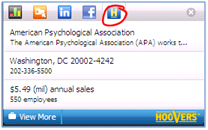
Further down. In the bottom half of the Xobni column, I get a list of people associated with the email sender in the “Network” area. When I send or receive email from a particular person, this box identifies who has been cc’ed on those various emails. Selecting one of them replaces the current Xobni profile with the profile of the person I have selected.
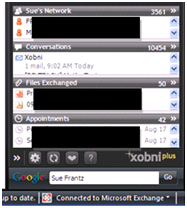
In the “Conversations” box, I get a list of all of the emails, clumped by subject line, I have exchanged with the person whose profile is displayed. Each threaded conversation is dated with the most recent first. Mousing over a conversation thread, like I’ve done here, produces a pop up window with a preview of the messages in the thread.
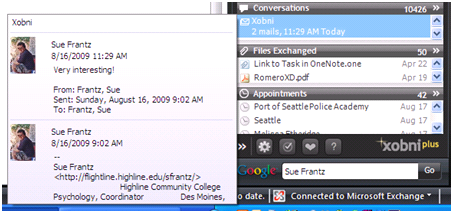
If I select the thread, the Xobni person profile is replaced with more detailed information.
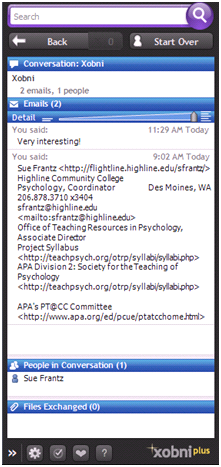
Then if I select a message within the thread, I can choose to open the message in Outlook or reply to the message directly from Xobni. Any time I want to go back, I just hit the “Back” button. If I want to go all the way back to the beginning, to the original profile where I started, I click “Start Over.”
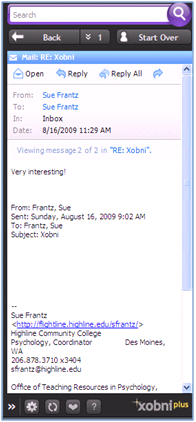
There’s a very similar process for “Files Exchanged.” Here I get a list of the files I’ve exchanged with that person, both ones I’ve sent and received. Mousing over the file name gives me information from the email the file came with as well as information about the file itself. Double clicking the file name will open the file.
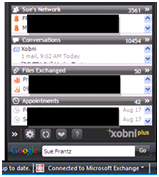
In the “Appointments” area I can see what upcoming appointments I have scheduled for the person whose Xobni profile I’m viewing. (Remember, to view a Xobni profile, just select the person’s email in Outlook.)
Search. With all of that said, the Xobni feature I cannot live without is search. In the search box, enter your search term, and Xobni will search people, email messages, appointments, and tasks. (In the free version, for messages, Xobni will only search subject lines and will search your current Outlook messages plus one archive file. Xobni Plus will search the message body in both your current Outlook messages and in an unlimited number of archive files.)
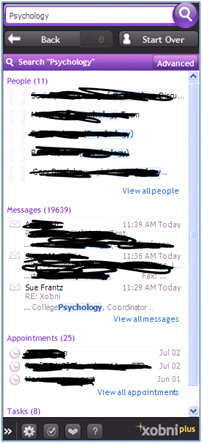
Download Xobni. Try it out. It’s free!
UPDATE (5/7/2010). Xobni released version 1.9 on April 14, 2010. The functionality is pretty much the same, but the user interface looks a little different. Xobni also now collects URLs exchanged between you and the person whose information you are looking at.
